What Is Oscar-Style Steak, Anyway?
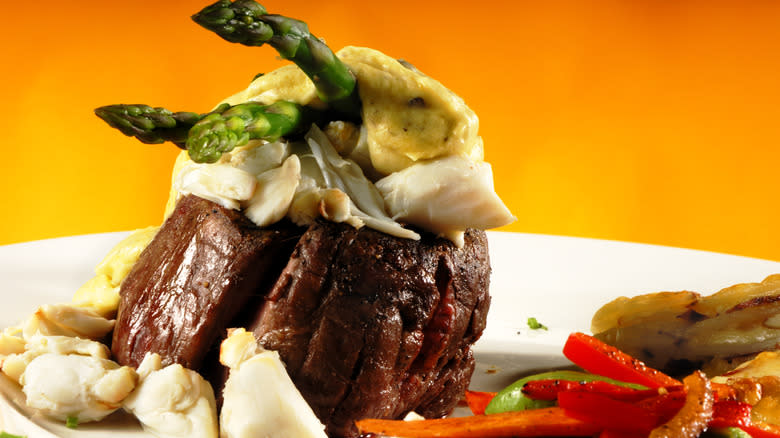
While many meat connoisseurs feel that a great steak stands on its own, needing no embellishment other than a sprinkling of salt or perhaps a pat of compound butter, other eaters prefer to take things over the top by piling on all manner of sauces and garnishes. Steakhouses may offer such add-ons as sauteed mushrooms, blue cheese crumbles, or shrimp as optional extras for a build-your-own steak, but Oscar-style steak is a dish that comes complete with a small mountain of toppings.
You can look at steak Oscar in one of two ways: It's either a really over-the-top main dish or else it's a mini-meal piled atop a single piece of meat. The steak is the meat, of course, while the seafood topper serves as an appetizer, and the asparagus spears are the side. The béarnaise sauce ties it all together while making for a far more elegant entree than steak served with a more plebeian sauce such as A.1. or Heinz 57.
Read more: Cuts Of Steak, Ranked Worst To Best
History Of Oscar-Style Steak
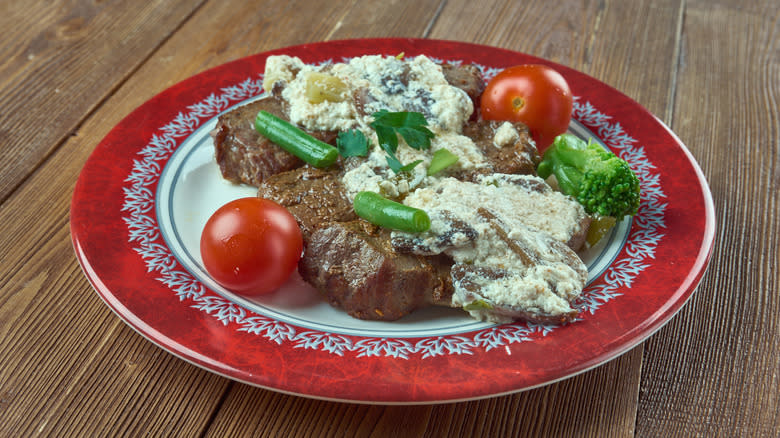
Steak Oscar may be a well-established menu staple at old-school steakhouses, but it's actually a knockoff of an earlier dish, that being veal Oscar. As with so many other famous recipes, it has several competing origin stories. One of these involves a man named Oscar Tschirky, a Swiss restaurateur at the Waldorf Astoria who also came up with Waldorf salad. The other, however, elevates the dish to royal status by claiming that it was created for (or in some cases, by) King Oscar II of Sweden. The stories sometimes involve a certain year, namely 1897, and a place, the Stockholm World's Fair. In the one that involves the fair, the dish was said to be made with lobster rather than crab and the sauce was tomato-based. One fun detail, however, is the fact that the latter was piped into an "O" for Oscar, thus honoring the king even if his supposed fondness for (or involvement with) the dish is apocryphal.
At any rate, veal has long since fallen out of favor as the protein of choice for an Oscar-style entree due to fairly obvious reasons. Veal, as a meat, has essentially been canceled, perhaps because most people these days are disinclined to eat cute baby animals (except lambs, since unfortunately for them, mutton tends to be on the tough side). What's more, the fact that veal may now be even more expensive than steak adds a little financial incentive to our moral indignation.
How Oscar-Style Steak Is Made?
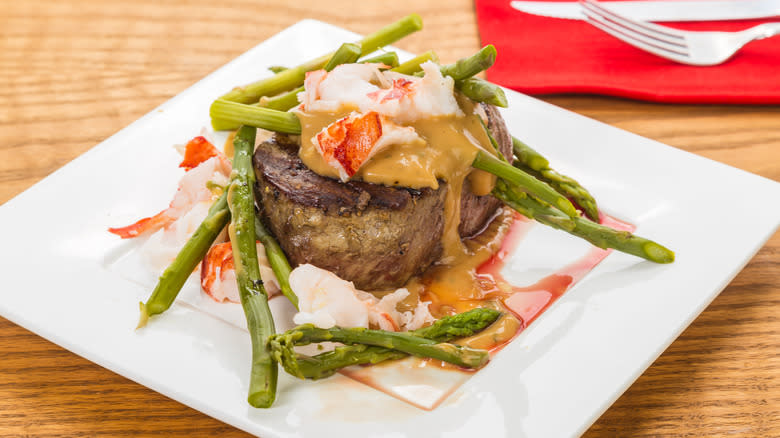
To cook your basic Oscar-style steak, you first need a steak, which will generally be one of the pricier cuts like filet mignon. You then cook the steak –- pan searing is generally acclaimed as the best method for the aforementioned filet as these don't do well on the grill, but the latter method will work if you opt for a heartier cut like a ribeye or t-bone. Smother the cooked stesk in crab meat which has been sauteed in butter and finish off the steak stack by artfully draping a few stalks of asparagus across the top. If you really want to be fancy, go with white asparagus as this is rarer and less asparagus-y tasting than the green kind, which is always a plus with those of us who aren't fans of this bitter-tasting plant. (Unfortunately, it still adds the same unpleasant odor to your urine as its more verdant counterpart.)
The crowning glory of steak Oscar is the béarnaise sauce. While this condiment isn't one of the famed five mother sauces of French cookery, béarnaise is essentially hollandaise (which is a mother sauce) made with tarragon and shallots. It may sometimes also include other ingredients such as vinegar, white wine, or vermouth in addition to or in place of the lemon juice.
Oscar-Style Variants
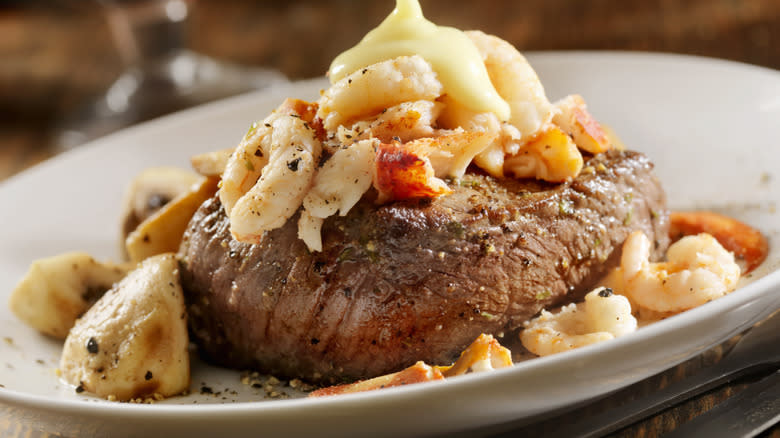
Many steak Oscar recipes do call for crab meat, and the origin stories involving King Oscar attribute this to the fact that it was said to be a favorite of his. It seems to be acceptable to use other types of shellfish, however, such as lobster or, for a more budget-priced version, shrimp. You can also, of course, use green asparagus if you can't find the white kind, and subbing hollandaise for béarnaise also seems to be a fairly standard variant of the dish. Some cooks even like to add little touches to either the sauce or the steak such as hot sauce or southwestern-style seasonings.
Oscar-style toppings can also be used for other types of protein, as well. As steak Oscar started off as veal Oscar, the former is technically a variant of the latter. Chicken breasts and pork tenderloin, too, can come in for the Oscar treatment, or even salmon for a double dose of seafood. Vegans, too, can tuck into a sort of Oscar-ish portabello mushroom made with dairy-free sauce, although theirs will be sans seafood since as of yet there's no good plant-based substitute for shellfish.
Where To Try Oscar-Style Steak
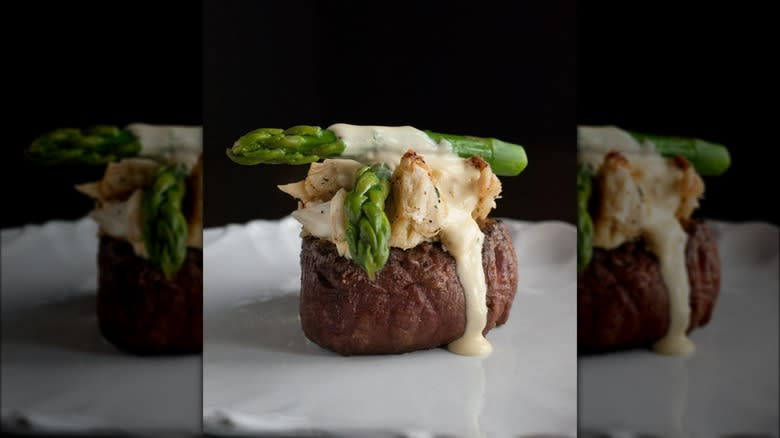
Not all steakhouses feature Oscar-style dishes on the menu – it's something you're unlikely to find at an Outback or Texas Roadhouse – yet there are quite a few traditional, yet upscale, eateries that do, These restaurants include indie steakhouses such as Taste of Texas in Houston, Prime in Bethlehem, Pennsylvania; Cotton Exchange in Waterford, Wisconsin; and Red Cabin at Green Acres in Fon Du Lac, Wisconsin. (The Badger State, after all, is supper club central.) You can also find steak Oscar offered by high-end chains such as Morton's The Steakhouse and Smith & Wollensky.
If you prefer to dine chez vous, a high-end meal delivery service such as The Austin Artisan may also feature Oscar-style entrees from time to time, although you'll only be able to avail yourself of such a service if you live in the applicable delivery area. Perhaps the most luxurious (if no doubt priciest) way to experience steak Oscar would be to book a stay at New York's Waldorf Astoria (which may or may not be the birthplace of the dish) as the hotel says it's still a popular item on the room service menu.
Read the original article on Mashed.

